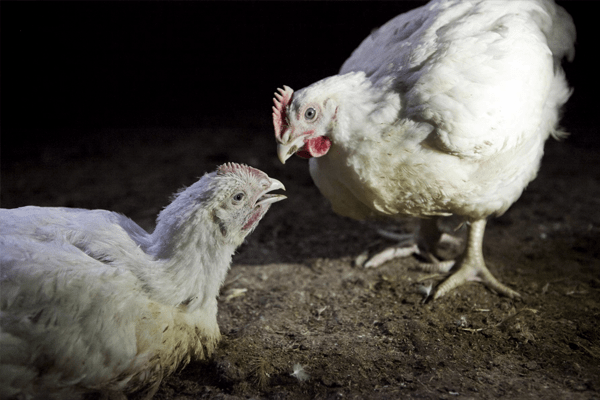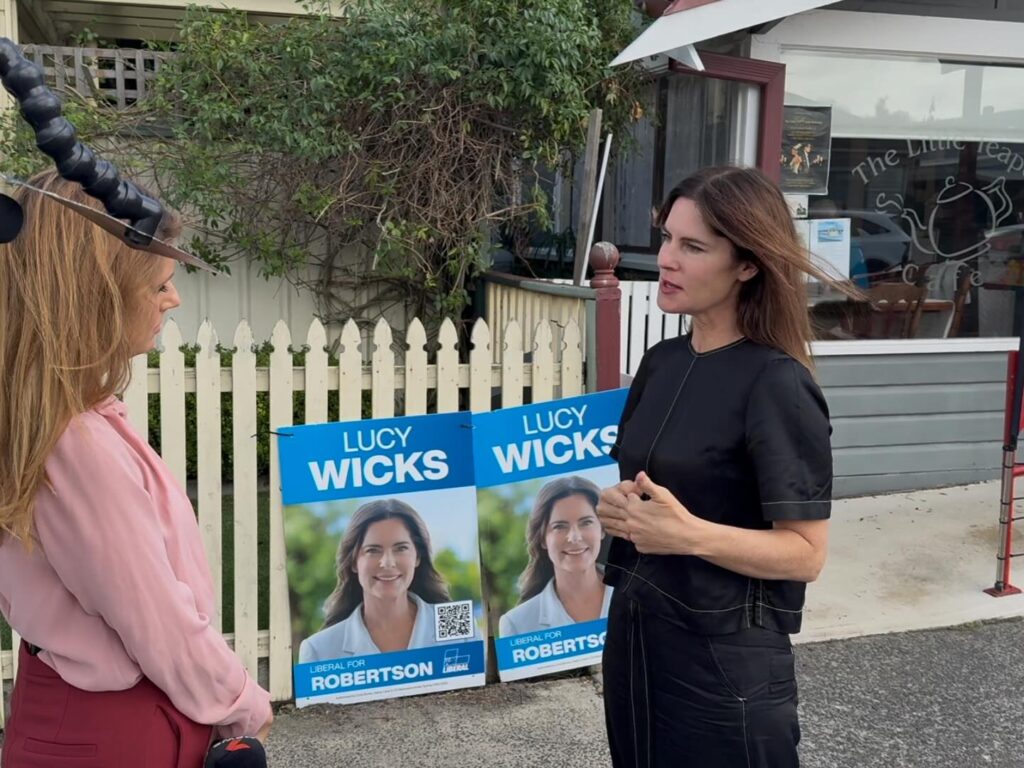Animal Liberation will be 50 years old in 2026 and it continues to work to improve the lives of all species through legislation, advocacy, action and legislation. Earlier this year the group held one of its slaughterhouse vigils.

By Lisa Ryan*
On 16 January 2025, Animal Liberation, together with Animal Rights Activism and Vegan Action Sydney, gathered to hold a peaceful vigil outside the Cordina chicken slaughterhouse in Girraween.
The vigil was organised to bear witness to broiler chickens, most of whom were under six weeks of age, during their final moments before slaughter.
Despite the peaceful nature of vigils, slaughterhouse management had hired four security guards for the event.
During 2024, a vigil was held at the same Girraween slaughterhouse in September; in December a vigil was held to bear witness to turkeys at a Southwest Sydney based slaughterhouse where approximately 27,000 young turkeys are slaughtered every week.
Around the world, according to data from the Food and Agriculture Organisation of the United Nations, 77 billion farmed animals are slaughtered globally each year. This equates to 211 million animals per day, 8.8 million per hour and 2,442 animals per second.
Other estimates put the global slaughter volume at 100 million animals per year. If you include fish, the slaughter volume runs into the trillions.
Routine cruelty
Most of these animals are still babies at the time of slaughter. Most are bred and raised in industrial, intensive agribusinesses, known as factory farms, where sentient beings are subjected to abject suffering and government-sanctioned and frequently legally exempted ‘routine’ cruelty.
These animal factory farms operate on a model of confining large numbers of animals in cages or sheds in overcrowded and often filthy environments for all their short lives, feeding them unnatural diets and inflicting routine, brutal and painful practices and procedures, often without pain relief.
These environments are cesspits and breeding grounds for abhorrent animal suffering and disease.
Global movement
The vigils form part of the global Animal Save Movement, inspired by the philosophies of Leo Tolstoy and Mahatma Gandhi, and the movement’s love-based approach to community organising and empathy.
Bearing witness is defined as not looking away and coming close to try and help the animals, in line with Tolstoy’s philosophy: “When the suffering of another creature causes you to feel pain, do not submit to the initial desire to flee from the suffering one, but on the contrary, come closer, as close as you can to he who suffers, and try to help.”
The Animal Save Movement was established in 2010 with the Canadian-based Toronto Pig Save, co-founded by Anita Krajnc and her rescue dog, Mr Bean.
During their morning walks, they witnessed the frightened pigs being transported to a nearby slaughterhouse in downtown Toronto. This moment ignited a promise to the pigs: to hold regular vigils outside slaughterhouses, bear witness to their suffering, and try to help spread the word.
The idea was to have people of all ages and classes, from children to grandmothers, join as a powerful force for change.
The aims of the movement include creating a nonviolent, vegan, healthy world that is just to all animals (including other-than-human and human animals), to help address catastrophic climate change through a reforested and rewilded planet.
With a deep understanding of the harmful risks and impacts of industrialised animal agriculture, as well as the close links between animals, the environment and people, the global Animal Save Movement has grown rapidly, resonating with people from all walks of life who want to stand up for animals.
What began as a local initiative in Toronto has become a global phenomenon which now spans about 900 chapters, branching beyond Animal Save into Climate Save and Health Save factions.
In 2024, the movement reached 998 million people through mainstream publications and more than 100 million people with powerful social media content.
The slaughter process
When the animals reach the industry’s desired slaughter weight, they endure often lengthy transport in all weather conditions, packed into overcrowded trucks which take them to their final and terrifying destination. For many, these journeys are often the first time these animals can see the sky or smell fresh air.
They live short, miserable lives, knowing and experiencing only ongoing suffering brought about by humans, and an insatiable appetite for animal-based products and commercial profits.
We know from many slaughterhouse exposures across Australia and around the world, that the stunning and slaughter process is violent, and animals fight to stay alive. No-one walks to a brutal death willingly at the hands of those who lack compassion.
While governments continue to convey a nauseating rhetoric about world’s best animal welfare and slaughter practices, and exposures by animal activists are deflected as ‘isolated incidents’, it’s all a con, designed to protect these abhorrent Industries and mislead consumers.
Exposures across Australia and around the world showing the violent brutality in slaughterhouses and frequent animal welfare breaches, all tell the same truth.
There are only so many times the public will accept the government’s ‘isolated incident’ catch cry.
In February 2012, Animal Liberation released footage exposing the Hawkesbury Valley Abattoir revealing acts of gross animal mistreatment, including animals being beaten before their slaughter. Some of the footage included pigs being dragged onto the sticking table and belted with what looks like an iron bar.
The slaughterhouse was shut down with the NSW Food Authority, who committed to undertaking a full investigation of slaughter practices. The NSW Department of Primary Industries said at the time, the abattoir had been inspected four times that previous year.
RSPCA NSW confirmed that this was not the first time the abattoir, a small family business, had been reported to the RSPCA and that they had received complaints [in] the past about the abattoir, but nothing that’s warranted a prosecution.
For transparency
Though a decision to install CCTV cameras was made, the footage is not publicly available. Without independent and transparent monitoring, how can the public have any confidence that the animal welfare laws, completely inadequate as they are, are being enforced?
The first vigil in NSW was held in 2017 at the Rivalea intensive piggery and slaughterhouse based at Corowa. The historic gathering was organised by Sydney Pig Save in conjunction with the Animal Save Movement and campaign managed by Animal Liberation’s Regional Campaigns Manager, Lisa Ryan.
Like most pig slaughterhouses, the Rivalea facility uses carbon dioxide (CO2) gas as a stunning method.
This facility is significant because it was where the world’s first footage was obtained and published showing the actual gassing process, and the immense pain and suffering experienced by pigs trapped in the gondolas as they were lowered into the gas chambers.
In 2024, over five million pigs were slaughtered in Australia for the pork industry, the vast majority in factory farms, with around 85% killed using CO2 gas.
The gassing of pigs has been condemned across Australia and the world on animal welfare grounds. Considered and promoted as ‘humane’ by the industry and government, footage shows the pigs thrashing, gasping and squealing as they are trapped in gondolas as they are lowered into pits of CO2, and are desperately trying to escape.
Since Animal Liberation’s early exposures, the Farm Transparency Project has exposed over 100 Australian slaughterhouses. While the animal species and geography vary, the brutality and breaches continue to be exposed with no meaningful change or protection for the animals.
Nothing humane ever happens in a slaughterhouse. These facilities are designed to kill, and supposed to ensure animals are quickly and painlessly stunned before being slaughtered. Instead, what we continue to see exposed is a violent end where animals are roughly and brutally handled, and are terrorised, while they fight to stay alive.
What you can do
Discover the diverse ways Animal Liberation advocates for animals in their upcoming webinar. From launching new campaigns against industry giants to championing plant-based choices and caring for companions, there’s so much to learn and discuss.
The webinar will include four speakers sharing insights that drive their work. This is an opportunity to deepen your understanding of animal rights issues, find out how you can get involved, and connect with our compassionate community.
Secure Your Spot:
- When: Thursday, 17 April 2025, 6:30 PM (Sydney Time / AEST)
- Where: Online via Zoom
- RSVP: Animal Liberation’s April Webinar
*Lisa Ryan is a regional campaign manager for Animal Liberation


